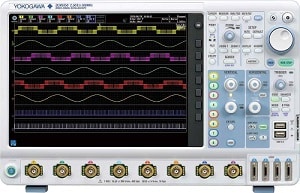- To counter the challenges while trying to simultaneously measure multiple signals, Yokogawa has introduced a high-performance mixed signal oscilloscope
- The device is suitable for applications ranging from design, development and debugging of electronic devices to measurement of analogue signals for ADAS development
 The need to develop energy and power-efficient motors, inverters and other devices for use in solar power and many clean energy applications has led to the need for measuring instruments that can simultaneously measure multiple control and communication signals.
The need to develop energy and power-efficient motors, inverters and other devices for use in solar power and many clean energy applications has led to the need for measuring instruments that can simultaneously measure multiple control and communication signals.
To meet this need and enable developers to speed up their product development efforts, Yokogawa Test & Measurement Corporation has developed and released the DLM5000 series mixed-signal oscilloscopes that offer high-speed processing function capability to handle large data volumes. The DLM5000 series provides optimal solutions to developers of advanced driver-assistance system (ADAS), mechatronics, industrial robots and the electronic control units (ECUs).
Applications
- Design and assessment of electric and electronic circuits.
- Development and debugging of semiconductors, electronic devices and embedded firmware.
- Simultaneous measurement of analogue signals and bus signals based on the CAN, CAN FD and other in-vehicle LAN standards (for ADAS development).
- Analysis of power and confirmation of the operation of power electronics.
- Simultaneous measurement and assessment of high-speed signals such as communication and mechatronics signals.
Product Features
1. Multiple channels for efficient measurement
The DLM5000 series models have either four or eight analogue input channels. With a single DLM5000 oscilloscope, it is possible to simultaneously view signals and inputs from up to eight analogue signals and a 16-bit logic channel (32-bit logic channel optional). When simultaneously measuring inputs from all analogue channels, a maximum sampling rate of 2.5 GS/s can be maintained.
2. Improved operability and reduced waiting time
The DLM5000 user interface includes a jog shuttle, rotary knobs and a large touch screen, which greatly simplify the viewing and analysis of waveforms.
A waveform processing engine speeds up data processing and saves time with the drawing of waveforms. The DLM5000 also supports the USB3.0 standard and rapidly transfers large amounts of data from multiple channels for storage on a PC, thus significantly reducing the waiting time.
3. More efficient analysis
The DLM5000 comes with a trigger function that supports the CXPI in-vehicle LAN standards. With a simultaneous display of both the waveform data and the signal analysis results, the correlation between these two data sets can be easily made.
The DLM5000 can store up to 500 M points of acquired data (twice that of the previous DLM4000 series). With this large memory, up to 100,000 waveforms can be automatically recorded in the internal storage, allowing easy search and comparison.
With a single DLM5000, users can also measure high-speed control signals that must be captured every GS/s and monitor the behaviour of devices such as brakes whose signals must be captured every several milliseconds. This improves efficiency.
A DLMsync option is planned to be released by next spring that will enable measurements to be taken accurately and simultaneously from up to 16 analogue channels and two 32 bit logic channels by connecting two DLM5000 oscilloscopes. This will offer even greater flexibility with the debugging of embedded systems.









